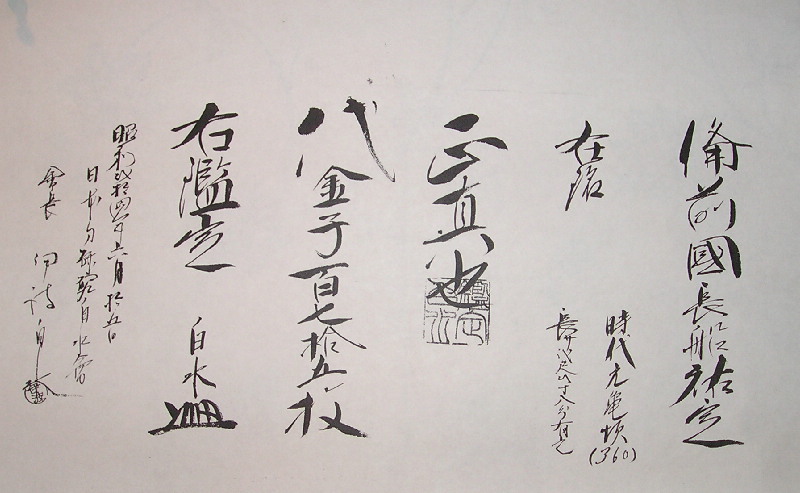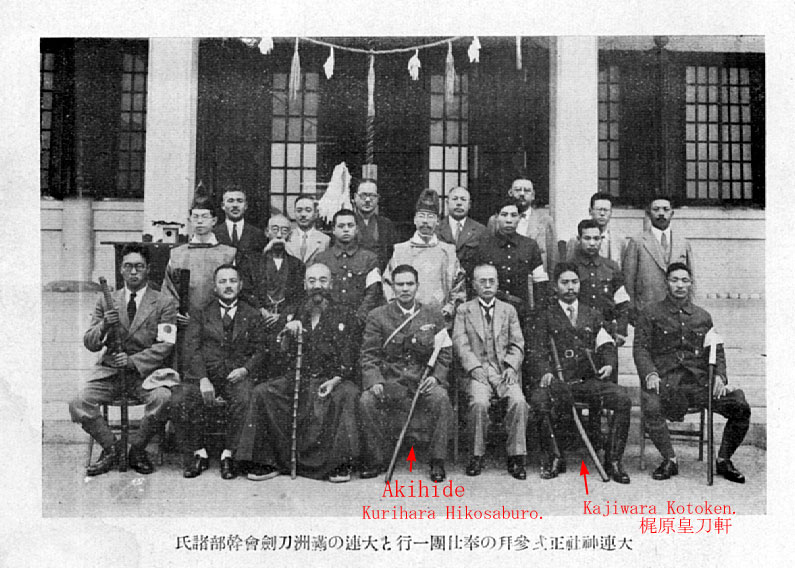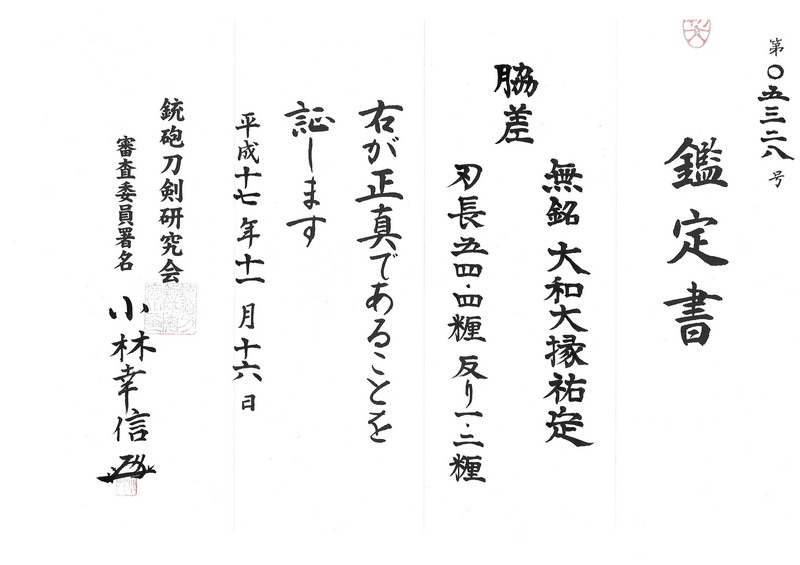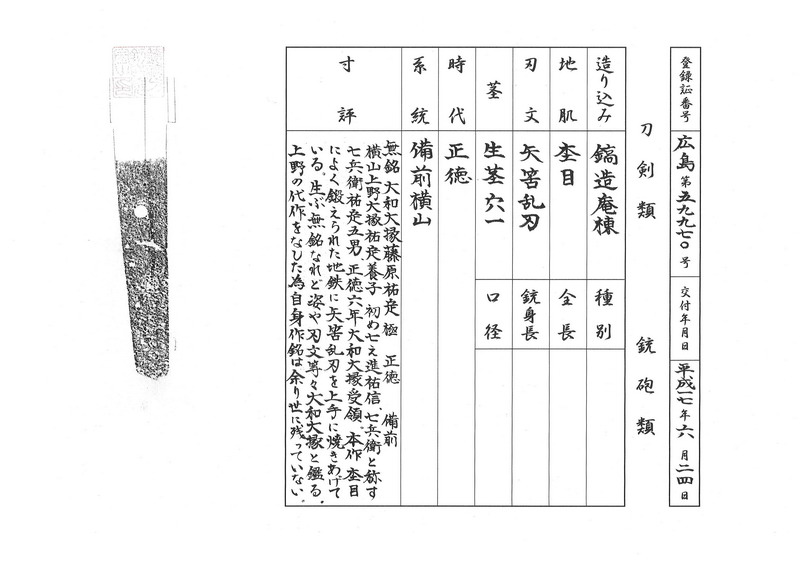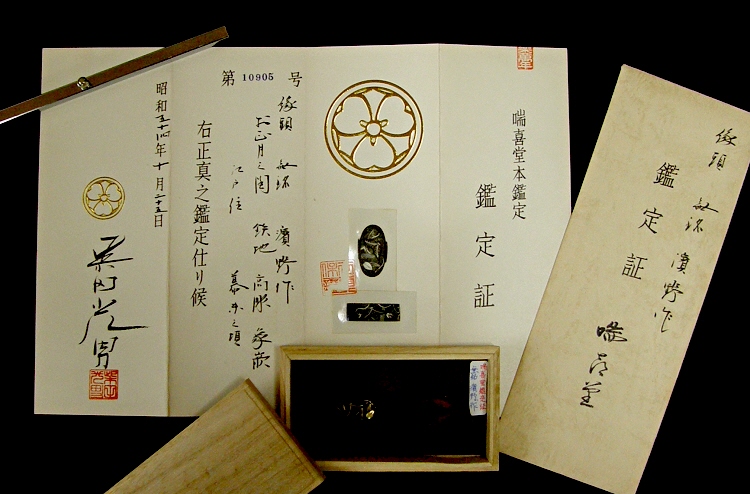NIHONTO and TOSOUGU ORIGAMI | |||
(Authentication/Appraisal Papers) | |||
|
Very few westerners have the expertise to judge accurately whether a signature is authentic or not. To be reasonably certain as to the maker of a specific sword, it is necessary to submit the sword for shinsa (judging) by one of the Japanese sword study associations (NBTHK, NTK or NTHK). These organizations will judge the sword and issue appropriate certificate (origami) attesting to the swords authenticity and/or historical importance. It is extremely rare to find a false certificate, for obvious reason that just one such Origami forever ruins the reputation of the man or group who accomplished it and renders valueless all that he/they have written in the past and any that he/they may write in the future. To further confuse the issue, the Origami are written in Japanese (Kanji/Hiragana/Katakana) and are therefore un-readable by the owner. I being the owner of five different appraisal groups origami, have taken it upon myself to translate (to the best of my ability) each one. The NBTHK and NTHK tend to stress different qualities in judging a sword. The NBTHK tends to judge rarity and historical importance as major factors whereas the NTHK judges condition of the sword as the primary factor. A sword to be submitted for shinsa should be in good to excellent polish; the higher the rating applied for, the better the polish must be. There are also various privately issued origami done by recognized Japanese scholars and individual sword authorities (NTK, Kotoken Kagihara, Fukunaga Suiken, Fujishiro). These can be beneficial in authenticating a sword, giving a different opinion of appraisal and issuing origami. The NBTHK, NTHK and NTK also issue origami for tsuba (sword guards), kodogu (fuchi-kashira or menuki) and koshirae (full mountings). | |||
FUKUNAGA SUIKEN |
Dr. Fukunaga Suiken is an expert in sword appraisal and author of many works on Japanese swords, one being one of the most popular appraisal manuals in Japan. There is also his magnum opus the 'Nihonto Daihyakka Jiten' a five volume encyclopedia of the Japanese sword. Fukunaga Sensei was very active in many of the sword groups including the NTHK under Yoshikawa Kentaro Sensei as well as the NBTHK, he is known for his scholarship and his past contributions to their publications and Shinsa. He issued his own appraisals for a time along with some written directly on the plain scabbard; sayagaki. He has in recent years re-joined the NTHK as an emeritus advisor. |
|
The example of a Fukunaga Suiken Kanteisho states the following information (reading from right to left) about a Kunishige blade:
|
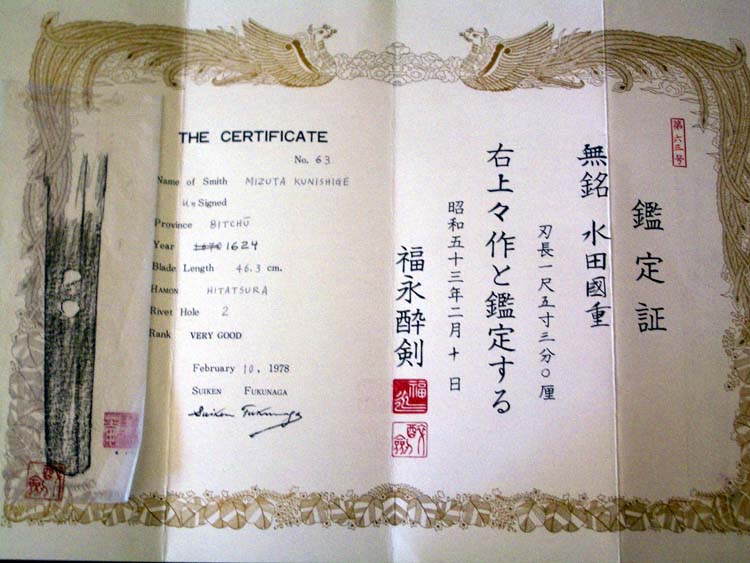 |
|
Example of a Fukunaga Hakogaki Kanteisho: |
HON'AMI KOSON |
Honami Koson was born in 1879 into a sword polishing family. His father was Kawaguchi Magotoro, whose name was formerly Sadakichi. Kawaguchi was retained as a sword polisher to the Matsudaira Family of the Maebashi clan. When Koson was 12 years old his family moved to Tokyo and when Koson reached the age of 19 years he apprenticed himself to Honami Ringa. He completed a 10 year apprenticeship under a very tough taskmaster, and then he became independent. When the Mito Honami master died, Honami Ringa used his influence to get Koson to be adopted into the Komi family and he became Honami Koson. . Koson believed that the exclusiveness of the Hon-ami family ‘secrets of kantei’ had hampered the development of the sword society. With a mind to disseminating information on the Japanese sword, he wrote and published a sword book titled NIHONTO in 1914. He wrote many sword books in his life, such as TOKEN KANTEI KOWA, NIHONTO TAIKAN, and NIHONTO NO OKITE TO TOKUCHO. Hon-ami Koson was the most famous and influential sword appraiser in the pre-war age. Albert Yamanaka studied under him and Nagayama Kokan was his most able apprentice. |
|
Example of a Hon'ami Koson Sayagaki and Origami |
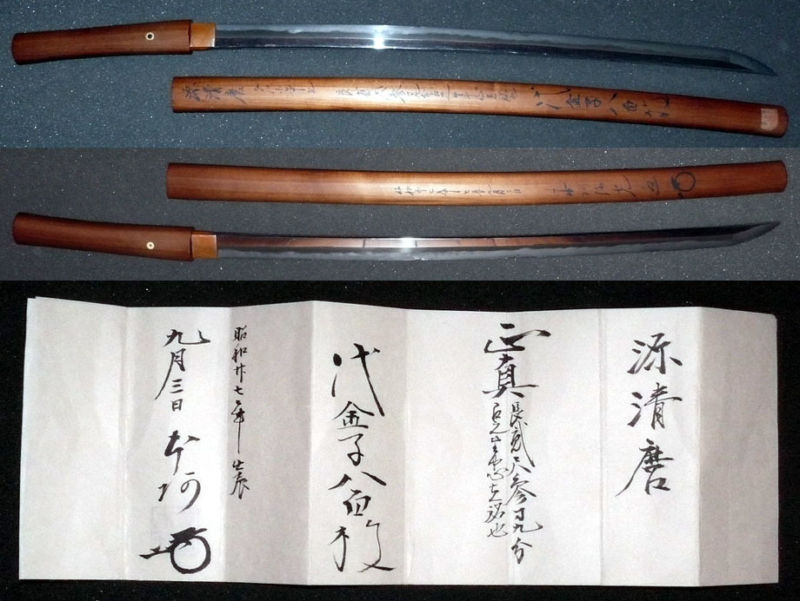 |
INAMI HAKUSUI |
Inami Hakusui started issuing origami in 1927. This occured after he and others had founded the Japanese Sword Research Society (or the Hakusui Association), the only organized group in Japan engaged in the study of Nippon-to and Nippon-to makers. Hakusui realized that the strong belief in the reliability of certificates of appraisal for swords meant that a piece is absolutely genuine, or is whatever it is claimed to be. |
JAPANESE MINISTRY OF EDUCATION |
The following ratings can only be granted by the Japanese Ministry of Education. These ratings are seen only on items of great artistic, cultural and historical value. Swords with these ratings are not found outside of Japan.
JUYO BIJUTSUHIN - "Important Art Object" |
Nihon Bijutsuhin Shinsakai |
KANTEI CLUB |
Kantei Club members are all board members of the Business Cooperative Association of Japanese Swords. Mr. Shibata Mitsuo is an appraiser of great distinction for swords and sword guards (see his kanteisho listed by name below).
According to the certificate, this tsuba was made by the founder Katsurano Sekibun, well-known as a master tsuba craftsman. Shown are the seals of appraisers such as Mr. Shibata Mitsuo, Arase Eiichi, Saito Mitsuki, Matsushima Toshio, Shibata Kazuo and Asakura Banko. |
KOTOKEN KAJIHARA |
|
READING KOTOKEN KAJIHARA ORIGAMI The Kotoken Kajihara origami for sword blades all have the same basic
column pattern (see the example below) with Appraisal Report (in English) below. |
NIHON BIJUTSU TOKEN HOZON KAI |
The NBTHK (Nihon Bijutsu Token Hozon Kai) has been issuing origami since the 1950's. They operate the Japanese Sword Museum in Tokyo. The NBTHK shinsa are held only in Japan. The nature and names of their origami have changed over time. The NBTHK issued the following types of origami starting in the 1950's. KICHO (white papers) - "Important Work" This ranking scale was changed in the 1980's. The current system of origami includes the following types of origami. HOZON - "Worthy of
Preservation" To be awarded Juyo papers a sword normally has first received one or both of the lower grade origami . |
Kicho (white paper) Awase Sanmei tsuba Tokubetsu Kicho (green paper) 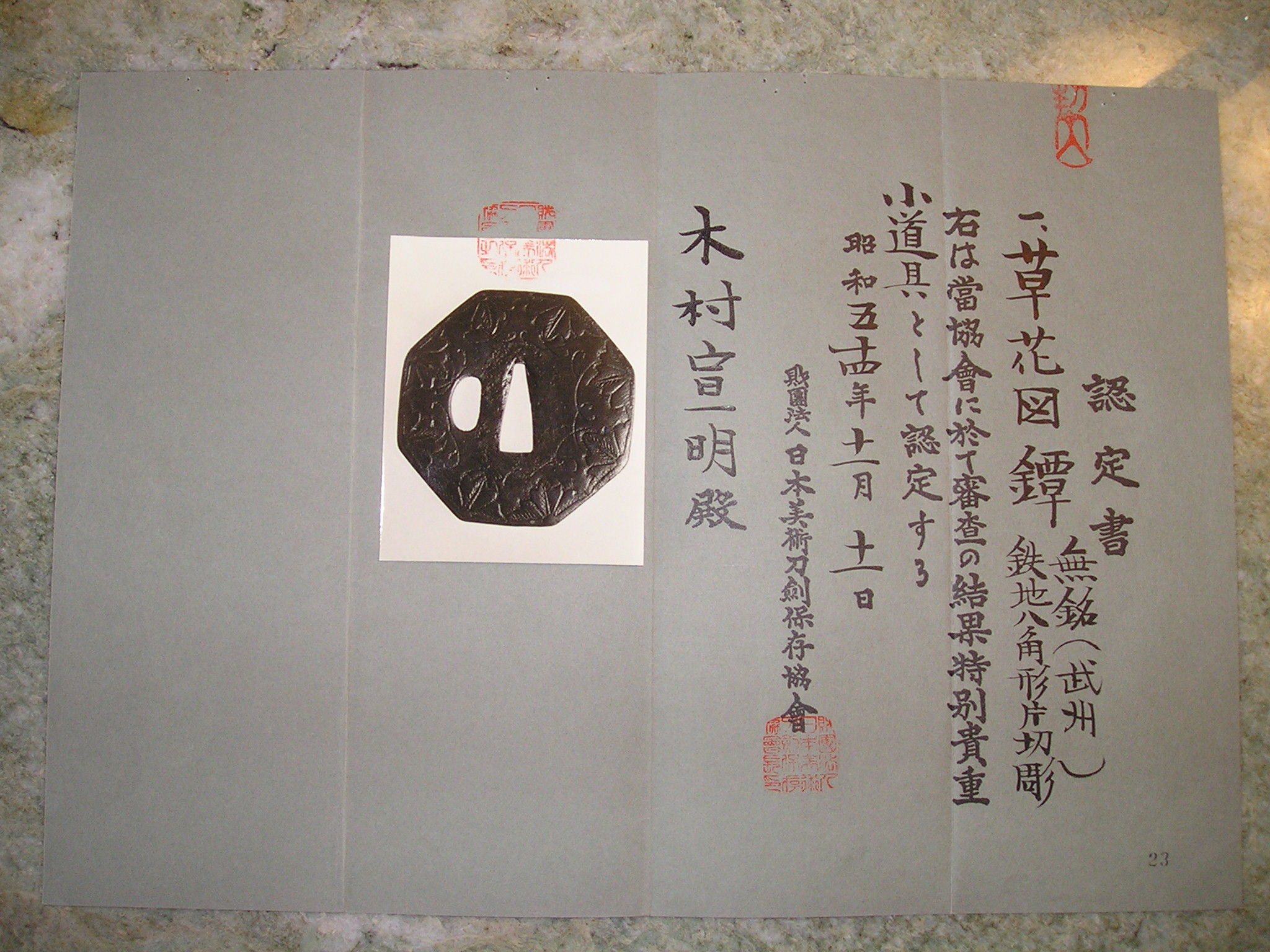 Bushu school tsuba |
READING NBTHK ORIGAMI
The current NBTHK origami for sword blades all have the same basic
seven column pattern (see the example below).
Reading the columns from right to left, the following information is given:
column one is "Kanteisho" (certificate of authenticity)
column two is the length of the blade (x shaku,
x sun, x bu)
column three will start "ichi" then
read either katana mei, wakizashi
mei, tanto mei or mu mei
depending on the blade.
This is followed by the signature on the nakago or an
attribution to the school and/or smith if the blade is mumei
(unsigned)
(attributions are commonly in parenthesis)
columns four and five will read -"This sword has been judged at the
NBTHK to be Hozon"
(or Tokubetsu Hozon, Juyo Token or Tokubetsu Juyo depending on the level of origami)
column six is the date of the shinsa
column seven is the NBTHK name and seal
A photograph or oshigata of the nakago
is attached at the far left of the origami.
The example of a NBTHK Hozon origami shown states the following information (reading from right to left) about the Shimada Den blade:
NIHON TOSOUGU BIJUTSUKAN |
The NTB (Nihon Tosogu Bijutsukan) was an organization dealing primarily with sword fittings (tosogu or kodogu) - tsuba, fuchi/kashira, menuki, and full koshirae. The NTB operated a museum, now closed, in Tokyo dedicated to the study and preservation of sword fittings. They also, issued origami for swords. Even though the NTB is no longer functioning, its origami are still held in high esteem. The NTB rating system was: Bunka Shiryoo - "Cultural Item" |
READING NTB ORIGAMI
NIHON TOKEN HOZON KAI |
| NIHONTO |
|
